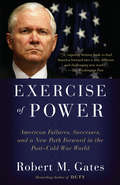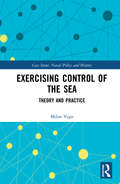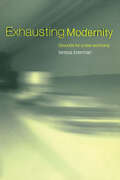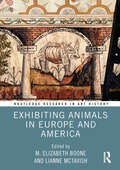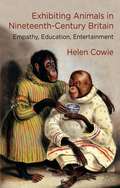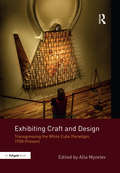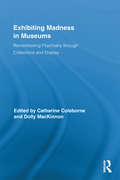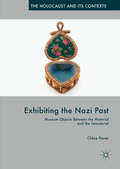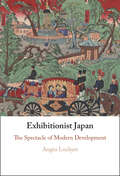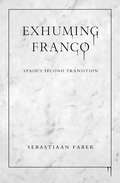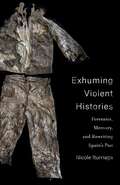- Table View
- List View
Exemptions: Necessary, Justified, or Misguided?
by Kent GreenawaltShould laws apply to everyone, or should some people be exempt because of conflicting religious or moral convictions? Through a close study of several cases, from abortion to taxes, Kent Greenawalt demonstrates how to weigh competing values without losing sight of practical considerations like the difficulty of implementing a specific law.
Exercise of Power: American Failures, Successes, and a New Path Forward in the Post-Cold War World
by Robert M. GatesFrom the former secretary of defense and author of the acclaimed #1 best-selling memoir, Duty, a candid, sweeping examination of power in all its manifestations, and how it has been exercised, for good and bad, by American presidents in the post-Cold War world.Since the end of the Cold War, the global perception of the United States has progressively morphed from dominant international leader to disorganized entity, seemingly unwilling to accept the mantle of leadership or unable to govern itself effectively. Robert Gates argues that this transformation is the result of the failure of political leaders to understand the complexity of American power, its expansiveness, and its limitations. He makes clear that the successful exercise of power is not limited to the use of military might or the ability to coerce or demand submission, but must encompass as well diplomacy, economics, strategic communications, development assistance, intelligence, technology, ideology, and cyber. By analyzing specific challenges faced by the American government in the post-Cold War period--Iran, Iraq, Afghanistan, North Korea, Syria, Libya, Russia, China, and others--Gates deconstructs the ways in which leaders have used the instruments of power available to them. With forthright judgments of the performance of past presidents and their senior-most advisers, firsthand knowledge, and insider stories, Gates argues that U.S. national security in the future will require learning, and abiding by, the lessons of the past, and re-creating those capabilities that the misuse of power has cost the nation.
Exercise, Respiratory and Environmental Physiology: A Tribute from the School of Milano (Perspectives in Physiology)
by Guido FerrettiThis book sheds new light on the history of exercise physiology and how it essentially grew, thanks to the work of a few major Schools. Analysing and interpreting the evolution of the field, the authors focus on the School of Milano, which was founded by Rodolfo Margaria and is one of the most prominent representatives, having played a central role in promoting and advancing this field of physiology. In turn, the authors trace Margaria’s biography; under his influence, the school introduced new concepts with regard to both the energetics of muscular exercise and to human locomotion. These concepts were further developed by Margaria’s pupils and by subsequent generations. Indeed, the course that was set in Milano greatly influenced the entire history of modern physiology. Readers with a keen interest in the origins of modern concepts and technologies in exercise physiology will find this book a fascinating and informative read.
Exercises in Programming Style
by Cristina Videira LopesThe first edition of Exercises in Programming Style was honored as an ACM Notable Book and praised as "The best programming book of the decade." This new edition retains the same presentation but has been upgraded to Python 3, and there is a new section on neural network styles. Using a simple computational task (term frequency) to illustrate different programming styles, Exercises in Programming Style helps readers understand the various ways of writing programs and designing systems. It is designed to be used in conjunction with code provided on an online repository. The book complements and explains the raw code in a way that is accessible to anyone who regularly practices the art of programming. The book can also be used in advanced programming courses in computer science and software engineering programs. The book contains 40 different styles for writing the term frequency task. The styles are grouped into ten categories: historical, basic, function composition, objects and object interactions, reflection and metaprogramming, adversity, data-centric, concurrency, interactivity, and neural networks. The author states the constraints in each style and explains the example programs. Each chapter first presents the constraints of the style, next shows an example program, and then gives a detailed explanation of the code. Most chapters also have sections focusing on the use of the style in systems design as well as sections describing the historical context in which the programming style emerged.
Exercising Control of the Sea: Theory and Practice (Cass Series: Naval Policy and History)
by Milan VegoThis book explains both the strategic and the operational aspects of exercising control of the sea. The struggle for sea control consists of three mutually related and overlapping phases: obtaining, maintaining and exercising sea control. It is in the phase of exercising sea control when one’s strategic or operational success is exploited; otherwise, the fruits of victories achieved would be wasted. This work describes the strategy of a stronger side in wartime after a desired degree of control has been obtained, which is followed by a discussion on the objectives and main methods used in exercising sea control. The remaining chapters explain and analyze in some detail each of the main methods of exercising sea control: defence and protection of one’s own and destruction/neutralization of the enemy’s military-economic potential at sea, capturing the enemy’s operationally important positions ashore, destroying/weakening the enemy’s military-economic potential ashore and supporting one’s ground forces in their offensive and defensive operations on the coast. This book will be of much interest to students of strategic studies, sea power and naval history.
Exeter in the Great War (Your Towns & Cities in the Great War)
by Derek TaitExeter played a vital role during the First World War supplying men for the Army and raising funds to help troops overseas. The Mayoress and her team played a key part collecting money to aid homeless Belgian refugees in the city while also supporting other worthy causes both home and overseas. Soldiers travelling through Exeter all received food, refreshments and cigarettes due to the money raised. The city had its own battalion, 'Exeter's Own' and thousands of servicemen passed through the city on their way to northern Europe. Players at Exeter City football club were amongst the first to join the Colours and later the Footballers' Battalion (the 17th Battalion Middlesex Regiment).The effect of the war on Exeter was great. By the end of the conflict, there wasn't a family in Exeter who hadn't lost a son, father, nephew, uncle or brother. There were tremendous celebrations in the streets as the end of the war was announced but the effects of the conflict lasted for years to come.
Exeter: Historically Speaking
by Barbara RimkunasIn March 1841, as townspeople flocked to the Exeter Courthouse to view a state-of-the-art diorama of the Conflagration of Moscow, the courthouse itself went up in flames. What was dubbed the Conflagration of the Courthouse is just one of the intriguing events revisited by historian Barbara Rimkunas in this collection. Exeter was also home to a score of eccentric personalities including Dick the fire horse, whose obituary in the town paper ran longer than that of the fire chief, and the mysterious Dr. Windship, a surgeon in the American Revolution who later earned the epithet of thief, fraudster and attempted bigamist. From scandals and Scotsmen to revolutionaries and river rats, Exeter: Historically Speaking reveals the many different threads with which Exeter's vibrant historical tapestry is woven.
Exhausting Modernity: Grounds for a New Economy
by Teresa BrennanExhausting Modernity is a bold new work on the exhaustion of our resources, both natural and human. Drawing on the insights of Marx and Freud, it provides a compelling analysis of the exhaustion pervading modern capitalism: environmental collapse, rising poverty levels and increasing global economic disparity. This is essential reading for political and social theorists, philosophers, economists, and all those interested in the environment.
Exhaustion: A History
by Anna K. SchaffnerToday our fatigue feels chronic; our anxieties, amplified. Proliferating technologies command our attention. Many people complain of burnout, and economic instability and the threat of ecological catastrophe fill us with dread. We look to the past, imagining life to have once been simpler and slower, but extreme mental and physical stress is not a modern syndrome. Beginning in classical antiquity, this book demonstrates how exhaustion has always been with us and helps us evaluate more critically the narratives we tell ourselves about the phenomenon.Medical, cultural, literary, and biographical sources have cast exhaustion as a biochemical imbalance, a somatic ailment, a viral disease, and a spiritual failing. It has been linked to loss, the alignment of the planets, a perverse desire for death, and social and economic disruption. Pathologized, demonized, sexualized, and even weaponized, exhaustion unites the mind with the body and society in such a way that we attach larger questions of agency, willpower, and well-being to its symptoms. Mapping these political, ideological, and creative currents across centuries of human development, Exhaustion finds in our struggle to overcome weariness a more significant effort to master ourselves.
Exhaustion: A History
by Anna Katharina SchaffnerToday our fatigue feels chronic; our anxieties, amplified. Proliferating technologies command our attention. Many people complain of burnout, and economic instability and the threat of ecological catastrophe fill us with dread. We look to the past, imagining life to have once been simpler and slower, but extreme mental and physical stress is not a modern syndrome. Beginning in classical antiquity, this book demonstrates how exhaustion has always been with us and helps us evaluate more critically the narratives we tell ourselves about the phenomenon.Medical, cultural, literary, and biographical sources have cast exhaustion as a biochemical imbalance, a somatic ailment, a viral disease, and a spiritual failing. It has been linked to loss, the alignment of the planets, a perverse desire for death, and social and economic disruption. Pathologized, demonized, sexualized, and even weaponized, exhaustion unites the mind with the body and society in such a way that we attach larger questions of agency, willpower, and well-being to its symptoms. Mapping these political, ideological, and creative currents across centuries of human development, Exhaustion finds in our struggle to overcome weariness a more significant effort to master ourselves.
Exhibiting Animals in Europe and America (Routledge Research in Art History)
by M. Elizabeth Boone Lianne McTavishThis edited volume, written by historians of art and visual culture who are working in the field of animal studies, seeks to understand how our ways of positioning (and ex-positioning) animals have separated us from the other-than-human animals that are an integral part of our interconnected world.Bringing together the visual and material culture of display with recent theoretical study on human–animal relations, the book draws attention to ways in which we might rethink this history and map pathways for the future. Defining the idea of exhibition and display broadly, chapters consider a diverse range of media, including paintings, anatomical sculpture, books, prints, and clothing; exhibition venues that take place in both the public and private realms; and key ideas such as looking at/looking back, seeing/being seen, and interspecies recognition. The authors cover topics that span the sixteenth through the early twentieth centuries and focus geographically on Europe and America, with significant content related to Canada, Indigenous America, and Latin America.The book will be of interest to scholars working in art history, visual studies, museum studies, animal studies, and environmental humanities.
Exhibiting Animals in Nineteenth-Century Britain
by Helen CowieIn an era of overseas exploration and imperial expansion, exotic animals were among the many foreign commodities to appear on British soil. They were a source of fascination to people across the social spectrum and served simultaneously as objects of entertainment, enlightenment and reflection. Focusing on zoos and travelling menageries in the period 1800-1880, Exhibiting Animals in Nineteenth-Century Britain explores how contemporaries thought about rare animals, where they encountered them and what symbolic, pedagogic and scientific value they attached to them. Helen Cowie uses animal exhibitions as a vehicle through which to examine issues of race, class, gender and colonialism. She devotes particular attention to travelling menageries, whose appeal transcended social boundaries and whose star exhibits included female lion tamers, 'ravenous hyenas' and pistol-firing elephants.
Exhibiting Atrocity: Memorial Museums and the Politics of Past Violence
by Amy SodaroToday, nearly any group or nation with violence in its past has constructed or is planning a memorial museum as a mechanism for confronting past trauma, often together with truth commissions, trials, and/or other symbolic or material reparations. Exhibiting Atrocity documents the emergence of the memorial museum as a new cultural form of commemoration, and analyzes its use in efforts to come to terms with past political violence and to promote democracy and human rights. Through a global comparative approach, Amy Sodaro uses in-depth case studies of five exemplary memorial museums that commemorate a range of violent pasts and allow for a chronological and global examination of the trend: the U.S. Holocaust Memorial Museum in Washington, DC; the House of Terror in Budapest, Hungary; the Kigali Genocide Memorial Centre in Rwanda; the Museum of Memory and Human Rights in Santiago, Chile; and the National September 11 Memorial Museum in New York. Together, these case studies illustrate the historical emergence and global spread of the memorial museum and show how this new cultural form of commemoration is intended to be used in contemporary societies around the world.
Exhibiting Blackness: African Americans And The American Art Museum
by Bridget CooksIn 1927, the Chicago Art Institute presented the first major museum exhibition of art by African Americans. Designed to demonstrate the artists’ abilities and to promote racial equality, the exhibition also revealed the art world’s anxieties about the participation of African Americans in the exclusive venue of art museums―places where blacks had historically been barred from visiting let alone exhibiting. Since then, America’s major art museums have served as crucial locations for African Americans to protest against their exclusion and attest to their contributions in the visual arts. In Exhibiting Blackness, art historian Bridget R. Cooks analyzes the curatorial strategies, challenges, and critical receptions of the most significant museum exhibitions of African American art. Tracing two dominant methodologies used to exhibit art by African Americans―an ethnographic approach that focuses more on artists than their art, and a recovery narrative aimed at correcting past omissions―Cooks exposes the issues involved in exhibiting cultural difference that continue to challenge art history, historiography, and American museum exhibition practices. By further examining the unequal and often contested relationship between African American artists, curators, and visitors, she provides insight into the complex role of art museums and their accountability to the cultures they represent.
Exhibiting Craft and Design: Transgressing the White Cube Paradigm, 1930–Present
by Alla MyzelevExhibiting Craft and Design: Transgressing the White Cube Paradigm, 1930–present investigates the ways that craft and design objects were collected, displayed, and interpreted throughout the second half of the twentieth century and in recent years. The case studies discussed in this volume explain the notion the neutral display space had worked with, challenged, distorted, or assisted in conveying the ideas of the exhibitions in question. In various ways the essays included in this volume analyse and investigate strategies to facilitate interaction amongst craft and design objects, their audiences, exhibiting bodies, and the makers. Using both historical examples from the middle of the twentieth century and contemporary trends, the authors create a dialogue that investigates the different uses of and challenges to the White Cube paradigm of space organization.
Exhibiting Europe in Museums: Transnational Networks, Collections, Narratives, and Representations
by Stefan Krankenhagen Kerstin Poehls Wolfram KaiserMuseums of history and contemporary culture face many challenges in the modern age. One is how to react to processes of Europeanization and globalization, which require more cross-border cooperation and different ways of telling stories for visitors. This book investigates how museums exhibit Europe. Based on research in nearly 100 museums across the Continent and interviews with cultural policy makers and museum curators, it studies the growing transnational activities of state institutions, societal organizations, and people in the museum field such as attempts to Europeanize collection policy and collections as well as different strategies for making narratives more transnational like telling stories of European integration as shared history and discussing both inward and outward migration as a common experience and challenge. The book thus provides fascinating insights into a fast-changing museum landscape in Europe with wider implications for cultural policy and museums in other world regions.
Exhibiting Health: Public Health Displays in the Progressive Era (Critical Issues in Health and Medicine)
by Jennifer Lisa KoslowIn the early twentieth century, public health reformers approached the task of ameliorating unsanitary conditions and preventing epidemic diseases with optimism. Using exhibits, they believed they could make systemic issues visual to masses of people. Embedded within these visual displays were messages about individual action. In some cases, this meant changing hygienic practices. In other situations, this meant taking up action to inform public policy. Reformers and officials hoped that exhibits would energize America's populace to invest in protecting the public's health. Exhibiting Health is an analysis of the logic of the production and the consumption of this technique for popular public health education between 1900 and 1930. It examines the power and limits of using visual displays to support public health initiatives.
Exhibiting Madness in Museums: Remembering Psychiatry Through Collection and Display (Routledge Research in Museum Studies)
by Catharine Coleborne Dolly MacKinnonWhile much has been written on the history of psychiatry, remarkably little has been written about psychiatric collections or curating. Exhibiting Madness in Museums offers a comparative history of independent and institutional collections of psychiatric objects in Australia, New Zealand, Canada and the United Kingdom. Leading scholars in the field investigate collectors, collections, their display, and the reactions to exhibitions of the history of insanity. Linked to the study of medical museums this work broadens the study of the history of psychiatry by investigating the significance and importance of the role of twentieth-century psychiatric communities in the preservation, interpretation and representation of the history of mental health through the practice of collecting. In remembering the asylum and its different communities in the twentieth century, individuals who lived and worked inside an institution have struggled to preserve the physical character of their world. This collection of essays considers the way that collections of objects from the former psychiatric institution have played a role in constructions of its history. It historicises the very act of collecting, and also examines ethical problems and practices which arise from these activities for curators and exhibitions.
Exhibiting the German Past
by Peter M. Mcisaac Gabriele MuellerWhile scholars recognize both museums and films as sites where historical knowledge and cultural memory are created, the convergence between their methods of constructing the past has only recently been acknowledged. The essays in Exhibiting the German Past examine a range of films, museums, and experiences which blend the two, considering how authentic objects and cinematic techniques are increasingly used in similar ways by both visual media and museums.This is the first collection to focus on the museum-film connection in German-language culture and the first to approach the issue using the concept of "musealization," a process that, because it engages the cultural destruction wrought by modernization, offers new means of constructing historical knowledge and shaping collective memory within and beyond the museum's walls. Featuring a wide range of valuable case studies, Exhibiting the German Past offers a unique perspective on the developing relationship between museums and visual media.
Exhibiting the Nazi Past: Museum Objects Between the Material and the Immaterial (The Holocaust and its Contexts)
by Chloe PaverThis book is the first full-length study of the museum object as a memory medium in history exhibitions about the Nazi era, the Second World War, and the Holocaust. Over recent decades, German and Austrian exhibition-makers have engaged in significant programmes of object collection, often in collaboration with witnesses and descendants. At the same time, exhibition-makers have come to recognise the degree to which the National Socialist era was experienced materially, through the loss, acquisition, imposition, destruction, and re-purposing of objects. In the decades after 1945, encounters with material culture from the Nazi past continued, both within the family and in the public sphere. In analysing how these material engagements are explored in the museum, the book not only illuminates a key aspect of German and Austrian cultural memory but contributes to wider debates about relationships between the human and object worlds.
Exhibitionist Japan: The Spectacle of Modern Development
by Angus LockyerFrom the second half of the nineteenth century, Japan has been a particularly enthusiastic user of exhibitions. Large-scale international exhibitions, including Osaka 2025, form only the tip of an iceberg comprising over 1,300 industrial, regional, and local exhibitions held in Japan over the past 150 years. In this unique history, Angus Lockyer explores how and why these events have been used as catalysts of development and arenas for fostering modern industry, empire, and nation. He traces their complicated genesis, realization, and reception, demonstrating that although they rarely achieve their stated aims, this does not undermine their utility – Japanese expos have provided a model subsequently adopted around the world. The history of this enthusiasm provides a more nuanced understanding of development in modern Japan, and emphasizes the shared experiences of global modernity.
Exhuming Franco: Spain's Second Transition, Second Edition
by Sebastiaan FaberThrough dozens of interviews, intensive reporting, and deep research and analysis, Sebastiaan Faber sets out to understand what remains of Francisco Franco's legacy in Spain today. Faber's work is grounded in heavy scholarship, but the book is an engaging, accessible introduction to a national conversation about fascism. Spurred by the disinterment of the dictator in 2019, Faber finds that Spain is still deeply affected—and divided—by the dictatorial legacies of Francoism. This new edition, with additional interviews and a new introduction, illuminates the dangers of the rise of right-wing nationalist revisionism by using Spain as a case study for how nations face, or don't face, difficult questions about their past.
Exhuming Violent Histories: Forensics, Memory, and Rewriting Spain’s Past
by Nicole IturriagaMany years after the fall of Franco’s regime, Spanish human rights activists have turned to new methods to keep the memory of state terror alive. By excavating mass graves, exhuming remains, and employing forensic analysis and DNA testing, they seek to provide direct evidence of repression and break through the silence about the dictatorship’s atrocities that persisted well into Spain’s transition to democracy.Nicole Iturriaga offers an ethnographic examination of how Spanish human rights activists use forensic methods to challenge dominant histories, reshape collective memory, and create new forms of transitional justice. She argues that by grounding their claims in science, activists can present themselves as credible and impartial, helping them intervene in fraught public disputes about the remembrance of the past. The perceived legitimacy and authenticity of scientific techniques allows their users to contest the state’s historical claims and offer new narratives of violence in pursuit of long-delayed justice.Iturriaga draws on interviews with technicians and forensics experts and provides a detailed case study of Spain’s best-known forensic human rights organization, the Association for the Recovery of Historical Memory. She also considers how the tools and tactics used in Spain can be adopted by human rights and civil society groups pursuing transitional justice in other parts of the world. An ethnographically rich account, Exhuming Violent Histories sheds new light on how science and technology intersect with human rights and collective memory.
Exile
by Jakob EjersboFor the vagabond pack of ex-pat Europeans, Indian Tanzanians and wealthy Africans at Moshi's International School, it's all about getting high, getting drunk and getting laid. Their parents - drug dealers, mercenaries and farmers gone to seed - are too dead inside to give a damn. Outwardly free but empty at heart, privileged but out of place, these kids are lost, trapped in a land without hope. They can try to get out, but something will always drag them back - where can you go when you believe in nothing and belong to nowhere? Exile is the first of three powerful novels about growing up as an ex-pat in Tanzania. Ejersbo's first novel, Nordkraft, the Danish Trainspotting, was a phenomenal bestseller. Ejersbo's trilogy, only published after his death in 2008, has proved to be another cult and critical sensation.
Exile (Lady Grace Mysteries #5)
by Grace CavendishThere's a new arrival--a mysterious and exotic young princess--at Court and Lady Grace can't believe how many rumours there are about her already. The exiled Banoo Yasmine from Sharakand is a beautiful girl with a pet panther and, everyone believes, magical powers. Yasmine also possesses the renowned Heart of Kings Ruby, a huge stone that she wears around her neck to balls and feasts, that legend says has the power to make kings. When the famed jewel goes missing, the finger is pointed at Grace's dear friend Ellie the laundry maid. Grace must prove her friend's innocence, find the true thief, and restore the stone to its rightful owner.

